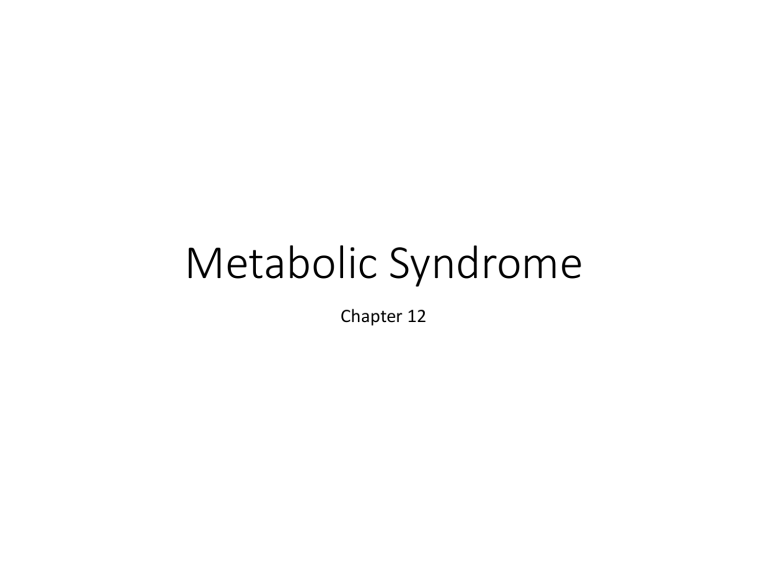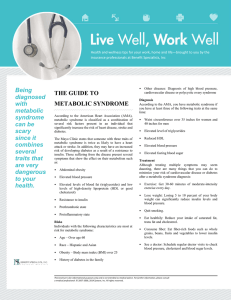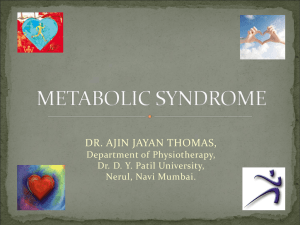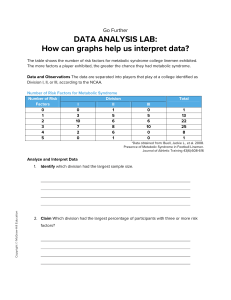
Metabolic Syndrome Chapter 12 Definitions • Metabolic syndrome • Collection of interrelated cardiometabolic risk factors that are present in a given individual more frequently than may be expected from a chance combination • Usually in the presence of overweight or obesity • Greater risk for developing atherosclerotic cardiovascular disease (ASCVD) • First observed – 1923 • Hypertension, hyperglycemia, hyperuricemia • Term first used – 1977 • Combination of dx a significant risk of arteriosclerosis due to cluster. Scope • Prevalence of metabolic syndrome Almost 34.3%, based on NHANES 2011-2012 data and ATP III criteria • Normal-weight obesity (Normal range BMI) • Abdominal obesity • Strongly associated with increased risk for cardiovascular mortality • Diabetes • Metabolically healthy obese • High BMI but normal cardiometabolic health • None of the diagnoses for MetS Definitions • Metabolic Syndrome • • • • • Obesity, Diabetes Hyperlipoproteinemia – form of dyslipidemia Hyperuricemia – increased uric acid Hepatic steatosis – fatty liver disease • 2009 – definitions • Table 12.1 Definitions • Metabolic syndrome – 3 or more conditions • Abdominal obesity • Elevated waist circumference • Elevated triglycerides • >150 mg/dl • Reduced HDLc • Men < 40 mg/dl • Women < 50 mg/dl • Elevated blood pressure • >130/85 mmHg • Elevated fasting glucose • >100 mg/dl Scope • Metabolic syndrome and the aging adult Prevalence increases with age and peaks around age 60 years • Pediatric metabolic syndrome ~42% aged 12 to 19 years present with one or more metabolic abnormalities • Economic burden 60% greater health care cost for those with metabolic syndrome • Obesity leads to more chronic disorders than smoking! NHANES 2003-2006 • Gender and ethnic diversities • Hispanic Americans highest risk (35.4%) • Non-Hispanic Whites (33.4%) • African Americans (32.7%) Pediatric MetS • NHANES 2001-2006: • 10% of 12-19 year old • 3 or more • Lack of norms for CVD risk factors • > 95th percentile – growth charts • Labeled obese • 85-95th percentile • Labeled overweight Pathophysiology • Characterized by a co-occurrence of • • • • • • Atherogenic dyslipidemia HTN Elevated glucose Chronic low-grade inflammation Prothrombosis Mitochondrial dysfunction • Widely thought to occur as a result of • Obesity (specifically android obesity) • Insulin resistance Pathophysiology • Previous conditions lead to • Diabetes • Atherosclerotic cardiovascular disease (ASCVD) • But – • These conditions do not always lead to MetS Components of Metabolic Syndrome Pathophysiology • MetS may be “premorbid” condition • Insulin resistance • Takes years to develop • Need to identify at risk individuals • Failure of insulin to maintain glucose homeostasis • Insulin receptor • Insulin signaling • Evidence of systemic inflammation, oxidative stress and endothelial dysfunction is occurring in MetS Non-alcoholic Fatty Liver-Steatosis Pathophysiology • Obesity and Ectopic Adiposity • Accumulation of fat in non-adipose tissue • Obesity – independent risk factor for • • • • Insulin resistance Hyperglycemia Dyslipidemia Hypertension • Untreated • Increased risk for chronic disease • Early all-cause mortality Pathophysiology • Visceral adipose tissue (VAT) • AKA ectopic • Fat accumulates in non-adipose areas • Lipotoxic • Disequilibrium between energy intake and expenditure • Skeletal muscle insulin resistance Pathophysiology • Mitochondrial dysfunction – decreased: • Size • Density • Function • Decreased ATP production • Decreased functional capacity • Energy deficit • Sedentary behavior – strong predictor of mitochondrial dysfunction Pathophysiology • Inflammation • Ectopic adiposity increases proinflammatory cytokines • Tumor necrosis factor-alpha • Interleukin-6 • Excess amounts • Triglycerides and cholesterol • Interferes with insulin signaling • Leads to cellular oxidative stress Clinical Considerations • Research continues to vary in definition of MetS • General findings • Increased cardiovascular events • ASCVD risk significantly higher • Increase in all cause mortality Clinical Considerations • Signs and symptoms • • • • • • • • Elevated fasting glucose Hypertension Elevated triglyceride levels Low high-density lipoprotein cholesterol level Abdominal obesity Microalbuminuria Hyperuricemia Fatty liver disease Clinical Considerations • Signs and symptoms (cont) • • • • • High levels of PAI-1 and fibrinogen (i.e., prothrombotic state) Elevated high-sensitivity C-reactive protein (hsCRP) (i.e., proinflammatory state) Cholesterol gallstones Polycystic ovary syndrome Disordered sleeping (e.g., sleep apnea) History and Physical • Identify the core risk components of metabolic syndrome. • 3 or more – increased risk • 1 or 2 – less risk of CVD • Monitor abdominal obesity. • Obtain clinical measure of waist circumference History and Physical • Appropriate risk assessment for patients diagnosed with metabolic syndrome should be based on the presence of • Dysglycemia • Impaired fasting glucose • • • • Hypertension Elevated triglyceride levels Low HDL Central obesity or high BMI Exercise Testing • According to ACSM, test not required to begin low- to moderateintensity exercise program • If test performed • Use standardized treadmill protocol • Low initial workload • Increase with small increments Exercise Testing • Standardized treadmill protocols that use: • Relatively small workload increases • 5 METs or less • Bruce Low Level Protocol (3 min stages) • Stage 1 1.2 mph/0% grade/2 METs Stage 2 1.2 mph/3% grade/2.5 METs Stage 3 1.2 mph/6% grade/3 METs Stage 4 1.7 mph/6% grade/3.5 METs Treatment • Interventions – reduce risk for ASCVD • Weight loss • Caloric restriction • Increased physical activity • Pharmacologic agents • Surgical procedures • Behavioral modifications • Improvements in diet quality • Participation in physical activity • Similar guidelines to those with obesity or diabetes • Smoking cessation (nicotine -> hypertension) • Not a criteria for MetS Exercise Prescription • Cardiovascular exercise • 150 to 250 min of moderate-intensity PA per week, • Energy equivalent of 1,200 to 2,000 kcal • Continuous or intermittent low intensity (40-60% VO2 or HRR) • To moderate intensity (50% to 75% VO2 or HRR) • Sessions should be 30 to 60 min in duration (minimum of 10 min for intermittent cardiovascular exercise) • Gradual progression in duration and intensity may be effective for chronic weight maintenance Exercise Prescription • Resistance exercise • No recommendations at present • Current minimums suggested • 2 to 3 d/wk • Single set of 5 to 10 exercises for whole body • Moderate intensity – 10-15 reps • Range of motion exercises • Stretching when warmed up • Include all major muscle groups • May need static stretching to begin • Hold stretch 15-60s Exercise Prescription Conclusions • Diagnosis of the metabolic syndrome requires presence of three or more of the following risk factors: • (1) elevated waist circumference, • (2) elevated triglycerides, • (3) reduced HDL cholesterol, • (4) elevated blood pressure, and • (5) elevated fasting glucose. Conclusions • When combined with dietary interventions • Cardiovascular exercise best means for weight loss • Recommended – 10% reduction • Aerobic exercise improves mitochondrial function • Increase in size • Increase in number




